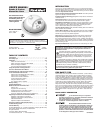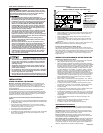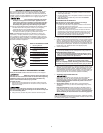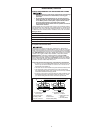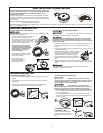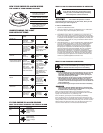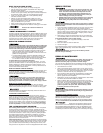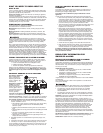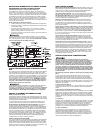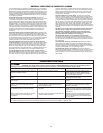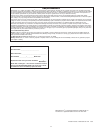
7
WEEKLY TESTING
•
NEVER use an open flame of any kind to test this unit. You
might accidentally damage or set fir
e to the unit or to your
home. The built-in test switch accurately tests the unit’
s
operation as r
equired by Underwriters Laboratories, Inc.
(UL). NEVER use vehicle exhaust! Exhaust may cause per
-
manent damage and voids your warranty.
•
DO NOT stand close to the Alarm when the horn is sounding.
Exposur
e at close range may be harmful to your hearing.
When testing, step away when horn starts sounding.
It is important to test this unit every week to make sure it is working
properly. Using the test button is the recommended way to test this
Smoke/CO Alar
m.
1.
Push and hold the Test/Silence button on the cover until you hear a
“chirp.” The “chirp” marks the start of the self-test sequence.
2.
During testing, you will hear a loud, repeating horn pattern: 3 beeps,
pause, 3 beeps, pause, while the r
ed smoke LED flashes. Then you
will hear a loud, repeating horn pattern: 4 beeps, pause, 4 beeps,
pause, while the r
ed CO LED flashes.
3.
When testing a series of interconnected units you must test each
unit individually. Make sure all units alarm when each one is tested.
If the Smoke/CO Alarm does not test properly:
1.
Make sure the AC power is applied and battery is fresh and
installed corr
ectly.
2. Be sure the alarm is clean and dust-free.
3.
Test the unit again.
If the Smoke/CO Alarm is still not working pr
operly
, replace it immediately.
Refer to the “Limited Warranty” at the end of this manual.
If ther
e is still a problem, do not try to fix the Alarm yourself.
This will void your war
ranty!
REGULAR MAINTENANCE
Use only the replacement batteries listed below. The unit may not
operate properly with other batteries. Never use rechargeable
batteries since they may not provide a constant charge.
This unit has been designed to be as maintenance-free as possible, but
there are a few simple things you must do to keep it working properly:
• Test it at least once a week.
• Clean the Smoke/CO Alarm at least once a month; gently vacuum
the outside of the Smoke/CO Alarm using your household vacuum’s
soft brush attachment. Test the Smoke/CO Alarm. Never use water,
cleaners or solvents since they may damage the unit.
• If the Smoke/CO Alarm becomes contaminated by excessive dirt,
dust and/or grime, and cannot be cleaned to avoid unwanted
alarms, replace the unit immediately.
• Relocate the unit if it sounds frequent unwanted alarms. See “Where
This Alarm Should Not Be Installed” for details.
• When the battery back-up becomes weak, the Alarm will “chirp”
about once a minute (the low battery warning). This warning should
last 7 days, but you should r
eplace the battery immediately to
continue your protection.
This Alarm must have AC or battery
power to operate. If AC power fails, and the battery is dead
or missing, the Alarm cannot operate.
DO NOT spray cleaning chemicals or insect sprays dir
ectly on or near
the Alarm. DO NOT paint over the Alarm. Doing so may permanently
damage the Alarm.
CHOOSING A REPLACEMENT BATTERY:
Y
our Smoke/CO Alarm requires one standard 9V battery. The following
batteries are acceptable as replacements: Duracell #MN1604, (Ultra)
#MX1604; Eveready (Energizer) #522. You may also use a Lithium
battery like the Ultralife U9VL-J for longer service life between battery
changes.
These batteries are available at many local retail stores.
Actual battery service life depends on the Smoke/CO Alarm and the
envir
onment in which it is installed. All the batteries specified above
ar
e acceptable r
eplacement batteries for this unit. Regardless of the
manufacturer’s suggested battery life, you MUST replace the battery
immediately once the unit starts “chirping” (the “low battery warning”).
WHA
T TO DO IN CASE OF FIRE
•
Don’t panic; stay calm. Follow your family escape plan.
•
Get out of the house as quickly as possible. Don’t stop to get
dressed or collect anything.
•
Feel doors with the back of your hand before opening them.
If a door is cool, open it slowly. Don’t open a hot door. Keep doors
and windows closed, unless you must escape thr
ough them.
•
Cover your nose and mouth with a cloth (preferably damp).
Take short, shallow breaths.
• Meet at your planned meeting place outside your home,
and do a head count to make sur
e everybody got out safely.
•
Call the Fire Department as soon as possible from outside.
Give your address, then your name.
• Never go back inside a burning building for any reason.
• Contact your Fire Department for ideas on making your home safer.
Alarms have various limitations. See "General Limitations of
Smoke/CO Alar
ms" for details.
“SMAR
T INTERCONNECT” FEATURE
This Alarm includes "Smart Interconnect" which enables the Alarm to be
inter
connected with other BRK Smoke, Heat, and "Smart Interconnect"
CO Alarms. When smoke is detected, all Alarms will sound the smoke
horn pattern. When CO is detected, "Smart Interconnect" Alarms will
sound the CO hor
n pattern. Alarms that do not have the "Smart
Inter
connect" Feature will remain silent during a CO alarm.
USING THE SILENCE FEATURE
N
EVER disconnect the power to your Smoke/CO Alar
m to silence the
hor
n—use the Silence Feature. Disconnecting the Smoke/CO Alarm
r
emoves your protection! If the unit will not silence or if it stays in
silence mode continuously
, it should be replaced immediately.
• The Silence Feature is intended to temporarily silence the horn
while you identify and correct the problem. Do not use the
Silence Feature in emergency situations. It will not correct a CO
problem or extinguish a fire.
• To use the Silence Feature, press the Test/Silence button until
you hear the acknowledge “chirp” or until the hor
n is silent.
• If the Test/Silence button is pressed while the Smoke/CO Alarm
is in the silence mode, the alarm will start sounding again.
To silence Alarms in an interconnected series:
To silence an interconnected series of Smoke/CO Alarms, you must
press the Test/Silence button on the initiating alarm (The unit with the
flashing red light; the red light will be off on all other Alarms.). If you
press the Test/Silence on any other Alarm, it will only silence that unit,
not the whole interconnected series.
WHEN THE SMOKE ALARM IS SILENCED...
The Smoke Alarm will remain silent for up to 15 minutes and then return
to normal operation. If the smoke has not cleared within the silence
period or if smoke increases to a critical level during the silence period,
the unit will go back into alarm.
Use the Silence Feature only if you are certain of the source of
smoke. If you are not certain of the source or a fire starts while
you are clearing smoke, evacuate the house immediately. Not
responding to an alarm can result in property loss, injury, or death.
WHEN THE CO ALARM IS SILENCED...
The CO Alarm will r
emain silent for 4 minutes. While the Alarm is
silenced, it will continue to monitor the air for CO. After 4 minutes, if CO
levels remain potentially dangerous the horn will start sounding again.
The Silence Feature is intended to temporarily silence the Alarm horn.
It will not corr
ect a CO pr
oblem.
LOW BATTERY SILENCE FEATURE
This Silence Feature can temporarily quiet the low battery warning
“chirp” for up to 8 hours if AC
power is pr
esent. Pr
ess the Test/Silence
button on the Alarm cover until you hear the acknowledge “chirp”.
Once the low battery warning “chirp” silence feature is activated, the
unit continues to flash the gr
een light once a minute for 8 hours. After
8 hours, the low battery “chirp” will r
esume.
The Alarm will continue to
operate as long as AC power is supplied. However, replace the battery
as soon as possible, to maintain protection in event of a power outage.
THE “LATCHING ALARM” INDICATOR:
The Latching Alarm Indicator is activated after an Alarm is exposed
to alarm levels of smoke or carbon monoxide. This feature will only
work with AC power
. After smoke or CO levels dr
op below alarm levels,
the red smoke or CO LED will begin to flash once every 5 seconds.
It will continue to flash or “latch” until you clear it by testing the alarm.
This featur
e helps emer
gency r
esponders, investigators, or service
technicians identify which unit(s) in your home were exposed to alarm
levels of smoke or carbon monoxide. This can help investigators
pinpoint the source of smoke or CO.
Interconnected Alarms. Latching Alarm Indicator shows which Alarm(s)
in the series were exposed to alarm levels of smoke or carbon monoxide.
The Latching Alarm Indicator stays ON until you clear it, so it can alert
you to an alarm that occurr
ed while you were away from home, even
though smoke or CO present in the air has dropped below alarm levels.



